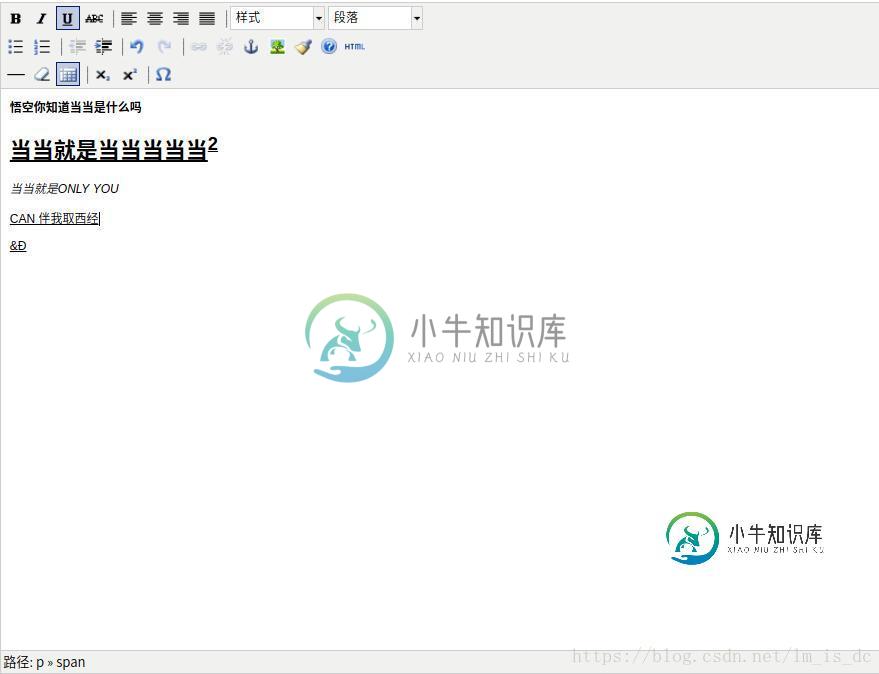Django之富文本(获取内容,设置内容方式)
富文本
1、Rich Text Format(RTF)
微软开发的跨平台文档格式,大多数的文字处理软件都能读取和保存RTF文档,其实就是可以添加样式的文档,和HTML有很多相似的地方
图示

2、tinymce插件
安装插件
pip install django-tinymce
配置插件
使用
后台管理中
HTMLField
页面中使用
textarea
3、在后台管理中使用
配置settings.py文件
INSTALLED_APPS 添加 tinymce 应用 INSTALLED_APPS = [ ... # 注册富文本应用 'tinymce', ]
添加默认配置
# 以字典形式配置富文本框架tinymce
# 作用于管理后台中的富文本编辑器
TINYMCE_DEFAULT_CONFIG = {
# 使用高级主题,备选项还有简单主题
'theme': 'advanced',
# 'theme': 'simple',
# 必须指定富文本编辑器(RTF=rich text format)的宽高
'width': 800,
'height': 600,
# 汉化
'language': 'zh',
# 自定义常用的固定样式
'style_formats': [
# title=样式名称
# styles=自定义css样式
# inline:xxx = 将加样式后的文本放在行内元素中显示
# block:xxx = 将加样式后的文本放在块级元素中显示
{'title': 'Bold text', 'inline': 'b'},
{'title': 'Red text', 'inline': 'span', 'styles': {'color': '#ff0000'}},
{'title': 'Red header', 'block': 'h1', 'styles': {'color': '#ff0000'}},
{'title': 'Example 1', 'inline': 'span', 'classes': 'example1'},
{'title': 'Example 2', 'inline': 'span', 'classes': 'example2'},
{'title': 'Table styles'},
{'title': 'Table row 1', 'selector': 'tr', 'classes': 'tablerow1'}
],
}
创建模型类
from tinymce.models import HTMLField class Blog(models.Model): sBlog = HTMLField()
注册模型
admin.site.register
4、在普通页面使用
使用文本域盛放内容
<form method='post' action='url'> <textarea></textarea> </form>
添加脚本
<script src='/static/tiny_mce/tiny_mce.js'></script>
<script>
tinyMCE.init({
'mode': 'textareas',
'theme': 'simple',
'theme': 'advanced',
'width': 800,
'height': 600,
'language': 'zh',
'style_formats': [
{'title': 'Bold text', 'inline': 'b'},
{'title': 'Red text', 'inline': 'span', 'styles': {'color': '#ff0000'}},
{'title': 'Red header', 'block': 'h1', 'styles': {'color': '#ff0000'}},
{'title': 'Example 1', 'inline': 'span', 'classes': 'example1'},
{'title': 'Example 2', 'inline': 'span', 'classes': 'example2'},
{'title': 'Table styles'},
{'title': 'Table row 1', 'selector': 'tr', 'classes': 'tablerow1'}
],
})
</script>
本质上还是使用html的样式。
5、利用js获取富文本内容和设置内容给富文本
//editorId是富文本的id
function SetTinyMceContent(editorId, content) {
//给富文本编辑器设置内容
tinyMCE.getInstanceById(editorId).getBody().innerHTML = content;
//获取富文本编辑器的内容
var con = tinyMCE.getInstanceById(editorId).getBody().innerHTML;
}
补充知识:Django中Form的Textarea字段
开始以为是这个样子:
class BlogForm(forms.Form): title = forms.CharField(required = True) content = forms.Textarea()
查看文档发现是:
from django import forms class BlogForm(forms.Form): title = forms.CharField(required = True) content = forms.CharField(widget=forms.Textarea)
以上这篇Django之富文本(获取内容,设置内容方式)就是小编分享给大家的全部内容了,希望能给大家一个参考,也希望大家多多支持小牛知识库。
-
主要内容:Jsoup 设置文本内容 语法,Jsoup 设置文本内容 说明,Jsoup 设置文本内容 示例以下示例将展示在将 HTML 字符串解析为 Document 对象后,如何使用方法设置、前置或附加文本到 dom 元素。 Jsoup 设置文本内容 语法 document : 文档对象代表 HTML DOM。 Jsoup : 解析给定 HTML 字符串的主类。 html : HTML 字符串。 div : 元素对象表示表示锚标记的 html 节点元素。 div.text() : text(co
-
问题 你需要修改一个HTML文档中的文本内容 方法 可以使用Element的设置方法:: Element div = doc.select("div").first(); // <div></div> div.text("five > four"); // <div>five > four</div> div.prepend("First "); div.append(" Last"); /
-
下面的示例将展示在将HTML String解析为Document对象之后使用方法来设置,预置或附加文本到dom元素。 语法 (Syntax) Document document = Jsoup.parse(html); Element div = document.getElementById("sampleDiv"); div.text("This is a sample conten
-
在程序入口文件index.js 中可以在init方法中获取server对象,通过该server可以获取config,具体方式如下: init(server, options) { const config = server.config(); const url = config.get('elasticsearch.url'); } 自定义配置 1.配置校验与默
-
还有一种调用模板的情况是我们只想渲染后返回模板渲染后的数据而不是直接输出,这时我们会用fetch方法; fetch的用法和display 完全一样,只是不直接输出了; //不带任何参数 $content=$this->fetch(); 此种方式系统会自动判断模板路径,并渲染出模板内容,此种方式模板路径是:主题名/应用名/控制器名/操作名+模板文件后缀名; $content=$this->fetc
-
本文向大家介绍python和shell获取文本内容的方法,包括了python和shell获取文本内容的方法的使用技巧和注意事项,需要的朋友参考一下 这两天搞脚本,花费不少时间。 Python和Shell都可以获取文本内容,网上许多资料介绍的都不具体。简单的使用Python和Shell写了脚本。 做一些笔记沉淀一下。 1、Python实现: 2、Shell实现: 以上这篇python和shell获取

